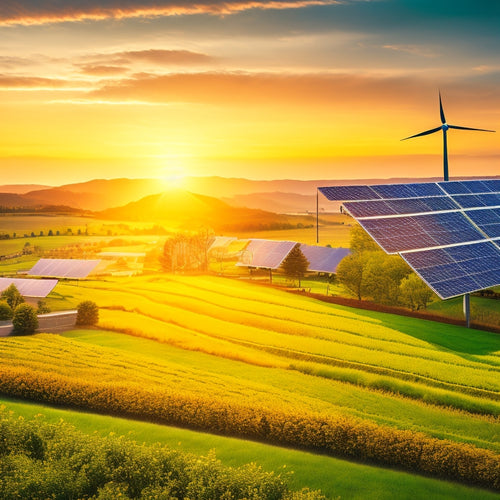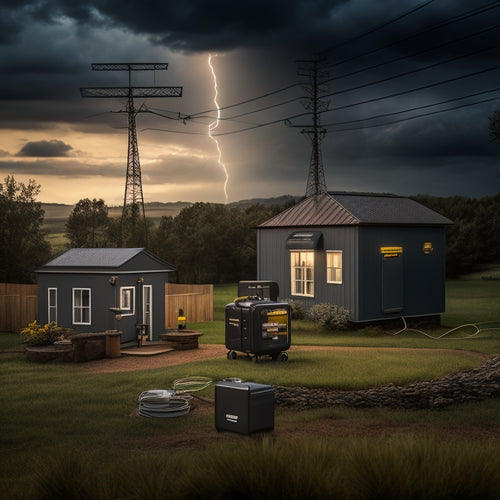
Energy Storage Units and the Renewable Revolution
Share
Energy storage units are essential to the renewable revolution, optimizing energy use while enhancing grid reliability. They balance supply and demand fluctuations, allowing you to employ renewable energy more effectively. By integrating these units into your energy infrastructure, you can lower costs, reduce reliance on fossil fuels, and achieve greater efficiency during peak times. Their advanced battery technologies, such as lithium-ion and flow batteries, offer unique advantages, ensuring you select the best option for your needs. As you investigate this topic further, you'll uncover more revelations on maximizing the benefits of energy storage.
At a Glance
- Energy storage units lower energy costs and enhance grid stability by efficiently utilizing renewable resources during peak demand.
- They facilitate the integration of renewable energy, improving grid reliability and reducing dependence on fossil fuels.
- Advanced battery technologies, like lithium-ion and flow batteries, optimize performance and efficiency for various storage needs.
- Effective management of renewable fluctuations ensures a consistent energy supply, aligning with sustainability goals.
- Assessing energy needs and selecting appropriate storage options are crucial for maximizing efficiency and achieving energy independence.
Cost-Effective Energy Solutions
To achieve cost-effective energy solutions, you need to focus on lowering energy costs and enhancing grid stability.
By integrating energy storage units, you can optimize resource use, reducing reliance on expensive peak power sources.
Battery performance factors play an essential role in determining the efficiency of these systems.
This approach not only saves money but also contributes to a more resilient energy infrastructure.
Lowering Energy Costs
Cost-effective energy solutions are changing the terrain of energy consumption, making it more accessible and sustainable for consumers and businesses alike. As you investigate energy price trends, it is crucial to understand how energy storage units can directly lower your costs. By adopting these technologies, you can utilize renewable energy when it's plentiful and use it during peak demand times, creating significant consumer savings.
Here's a snapshot of how energy storage impacts costs:
| Energy Storage Benefits | Impact on Costs |
|---|---|
| Peak Shaving | Reduces demand charges |
| Time-of-Use Optimization | Lowers electricity rates |
| Renewable Integration | Minimizes reliance on fossil fuels |
| Emergency Backup | Avoids costly outages |
Enhancing Grid Stability
Energy storage units not only help reduce costs but also play a vital role in enhancing grid stability. By smoothing out fluctuations in energy supply and demand, these units guarantee that renewable energy integration is seamless and efficient. When the sun shines or the wind blows, energy storage captures excess generation, preventing waste and maintaining a balanced grid.
Implementing effective grid resilience strategies is fundamental for adapting to the increasing variability of renewable sources. Energy storage solutions act as a buffer, providing power during peak demand periods and in times of generation shortfalls. This flexibility strengthens grid reliability, allowing you to utilize renewables without compromising stability.
Moreover, energy storage units enable rapid response to outages and fluctuations, which enhances overall system resilience. They can be deployed quickly in response to unforeseen events, assuring continuity of service.
As you consider shifting to renewable energy, remember that investing in energy storage not only supports your independence but also reinforces the grid against disruptions.
Ultimately, embracing energy storage is vital for achieving a stable, resilient energy future—one that liberates you from dependency on fossil fuels and promotes a sustainable, self-sufficient lifestyle.
Enhanced Grid Stability
Energy storage units play an essential role in enhancing grid stability by managing fluctuations in renewable energy sources. By absorbing excess energy during peak production and releasing it during low generation periods, they help maintain a balanced supply.
This capability is vital for integrating more renewables into the grid without compromising reliability. Additionally, solar battery storage systems, which can achieve up to 98% round-trip efficiency, further contribute to this stability by optimizing energy management and reducing reliance on the grid, ultimately supporting energy independence.
Role of Energy Storage
The integration of energy storage units greatly improves grid stability, addressing the intermittent nature of renewable energy sources like solar and wind. As you engage in the energy shift, you'll find that storage innovations are essential in mitigating supply-demand mismatches, allowing for a more reliable energy system.
Here's a concise overview of the benefits of energy storage:
| Benefit | Description | Impact on Grid Stability |
|---|---|---|
| Frequency Regulation | Balances short-term fluctuations in demand | Reduces risk of blackouts |
| Load Shifting | Stores excess energy for use during peak demand | Enhances reliability |
| Renewable Integration | Facilitates higher penetration of renewables | Lowers dependency on fossil fuels |
| Emergency Backup | Provides power during outages | Increases resilience |
| Cost Efficiency | Reduces need for expensive peaker plants | Lowers overall energy costs |
Managing Renewable Fluctuations
As renewable energy sources fluctuate throughout the day, managing these variations becomes vital for maintaining grid stability. You're likely aware that integrating renewable resources, such as solar and wind, into the energy mix introduces significant challenges. Their intermittent nature demands effective fluctuation management strategies to guarantee a reliable supply.
Energy storage units play a significant role in this process. By capturing excess energy during peak production times, they provide a buffer against dips in generation. When the sun sets or winds die down, these units discharge stored energy, addressing demand without relying on fossil fuels. This flexibility not only enhances grid stability but also supports the broader goal of renewable integration.
To further optimize management, advanced forecasting technologies can predict energy availability and demand fluctuations. By utilizing real-time data, you'll improve operational decision-making, confirming that energy supply aligns with consumption patterns. This proactive approach minimizes disruptions and maximizes the utilization of renewable resources.
In essence, excelling at fluctuation management is vital for achieving a sustainable, resilient energy grid. It enables you to tap into the full potential of renewables while maintaining the freedom and reliability consumers expect.
Technical Specifications Overview
In understanding energy storage units, you'll need to take into account the various battery chemistry types, as each has distinct characteristics affecting performance.
For instance, battery types and selection play an essential role in determining efficiency and suitability for different applications.
Capacity and efficiency metrics play significant roles in determining how well these systems meet energy demands.
Battery Chemistry Types
Understanding battery chemistry types is vital for evaluating energy storage solutions. You'll encounter various technologies, each with unique benefits and challenges.
Lithium ion advancements have dominated the market due to their high energy density improvements, but solid state innovations are emerging, promising enhanced safety and longevity.
Flow battery applications offer scalability, making them ideal for large-scale energy storage, while organic battery development focuses on sustainable materials.
Supercapacitor technology addresses rapid charge and discharge needs, complementing other battery types in hybrid storage solutions.
Thermal energy storage is another notable approach, utilizing heat for energy conservation, particularly in solar applications.
As you investigate these options, consider battery recycling strategies, which are imperative for sustainable practices in energy storage.
Recent developments in nano material enhancements have also contributed to improved performance across various battery chemistries, enhancing efficiency and lifespan.
Capacity and Efficiency
Evaluating energy storage solutions involves closely examining capacity and efficiency metrics, which are critical for determining overall performance.
Capacity refers to the maximum amount of energy a storage unit can hold, typically measured in kilowatt-hours (kWh). Higher capacity allows for greater energy storage, which is essential for meeting your demands during peak usage times.
On the other hand, efficiency metrics indicate how much of the stored energy can be effectively employed. This is often expressed as a percentage, with higher percentages signifying less energy loss during storage and retrieval. Aspiring for capacity optimization means you'll want to select systems that not only maximize storage but also maintain high efficiency.
Various technologies offer different balances of capacity and efficiency. For instance, lithium-ion batteries often excel in efficiency but may face limitations in capacity compared to larger flow batteries.
When evaluating your options, consider how these factors align with your energy needs and goals. Ultimately, understanding these metrics enables you to make informed decisions, enhancing your ability to leverage renewable energy effectively and sustainably.
Selecting Based on Capacity Requirements
When selecting energy storage units, you need to assess your energy needs carefully.
Understanding the various storage options available will help you choose a system that aligns with your capacity requirements. This guarantees optimal performance and efficiency in your renewable energy setup.
For instance, exploring high round-trip efficiency options can greatly enhance your energy savings and reliability.
Additionally, considering factors such as installation compatibility and scalability will further improve your energy storage solution.
Assessing Energy Needs
Energy independence hinges on accurately evaluating your energy needs, especially when selecting storage units based on capacity requirements.
Start by analyzing your energy demand patterns. Identify peak consumption times and seasonal variations to gauge how much energy you require. Load forecasting techniques can help predict future energy needs, guaranteeing you prepare adequately for fluctuations.
Consider how renewable integration plays a role in your energy strategy. As you incorporate solar or wind systems, it's vital to align your storage capacity with the energy generated. This guarantees that you meet your sustainability goals without over-relying on the grid, consequently enhancing your energy independence.
Think about the environmental impact of your choices. An appropriate energy storage unit not only supports your current needs but also contributes to grid resilience. By selecting the right capacity, you'll minimize waste and optimize efficiency.
Ultimately, understanding your energy requirements is fundamental for achieving a sustainable energy future. It enables you to make informed decisions that align with your values while promoting a cleaner, more resilient energy environment.
Stay proactive in evaluating your needs to encourage both personal autonomy and broader environmental benefits.
Understanding Storage Options
With a clear understanding of your energy needs established, the next step is to investigate the storage options available to you. Selecting the right storage solution hinges on your capacity requirements and specific energy demands.
Two prominent technologies deserve your attention: pumped storage and thermal energy systems.
Pumped storage operates by using excess energy to pump water uphill into a reservoir. When demand spikes, this stored potential energy can be released, generating electricity as the water flows back down. It's highly efficient, offering rapid response times, making it an excellent choice for balancing intermittent renewable sources like solar and wind.
On the other hand, thermal energy storage captures excess energy in the form of heat. This method can store energy during off-peak hours, utilizing materials like molten salt or water. When energy is needed, you can convert this stored heat back into electricity or use it directly for heating applications, ensuring your energy independence.
Ultimately, the decision between pumped storage and thermal energy depends on your unique capacity needs and usage patterns. Assess the specific advantages of each system to align with your energy goals and maintain your freedom in energy choices.
Longer Lifespan Than Competitors
When you evaluate energy storage units, consider those with enhanced durability features.
These units not only extend operational lifespan but also reduce long-term costs associated with replacements.
Enhanced Durability Features
The extraordinary durability of modern energy storage units sets them apart from competitors, making them a smart investment for long-term applications.
You'll find that these units employ advanced materials designed to withstand harsh environmental conditions, guaranteeing they can handle fluctuations in temperature, humidity, and mechanical stress. This resilience translates directly into a longer lifespan, minimizing the need for frequent replacements.
Performance testing plays a critical role in validating these durability claims. Through rigorous assessments, manufacturers confirm that their products maintain efficiency even after extensive cycles of charge and discharge. This not only enhances reliability but also increases your confidence in their long-term performance.
Moreover, improved durability features mean you can enjoy greater freedom in choosing installation locations, whether on rooftops or in remote areas.
You won't have to worry as much about maintenance or degradation, allowing you to focus on maximizing your energy independence.
Investing in these advanced energy storage units means you're opting for sustainability without compromising on reliability.
As you adopt renewable energy solutions, knowing that your storage system will stand the test of time is essential for achieving true energy autonomy.
Frequently Asked Questions
How Do Energy Storage Units Impact Local Job Creation?
Energy storage units create significant job opportunities by stimulating local economies. They require skilled workers, prompting workforce training programs that enhance employability and cultivate community growth, while driving innovation and sustainability in various sectors.
What Are the Environmental Effects of Manufacturing Storage Units?
Manufacturing storage units releases a tidal wave of emissions, ravaging the environment. Resource extraction devastates ecosystems, leading to pollution and habitat loss. You're left wrestling with the trade-offs between technological advancement and ecological preservation.
Can Energy Storage Units Be Recycled at End-Of-Life?
Yes, energy storage units can be recycled at end-of-life. By implementing effective battery recycling processes and end of life management strategies, you'll minimize waste and recover precious materials, promoting sustainability and freedom from environmental impact.
How Do Energy Storage Units Enhance Energy Independence for Communities?
Energy storage units enhance communities' energy independence by improving grid resilience. You enable your neighborhood to manage energy demands, reducing reliance on external sources and cultivating a sense of freedom, security, and self-sufficiency for all residents.
What Are the Most Common Misconceptions About Energy Storage Technologies?
You might think battery efficiency equals reliability, but misconceptions persist. Many underestimate how energy storage enhances grid stability, believing it only benefits large systems. In reality, it's essential for local energy resilience and independence.
Explore More
So, if you're still clinging to outdated energy sources, you might want to reconsider. Embracing energy storage units isn't just a trend; it's a necessity for grid stability and cost efficiency. Sure, some might prefer watching their power bills soar, but for the rest of us, the longer lifespan and customized capacity of these units make them the smart choice. After all, who wouldn't want to join the renewable revolution instead of being left in the dark ages?
Related Posts
-

Net Metering in Renewable Energy's Future
Net metering's future is vital for driving renewable energy growth and financial savings. You can reduce your electri...
-

Key Components of a Reliable Emergency Power Supply System
A reliable emergency power supply system requires several key components. You need proven performance metrics to guar...
-

Solar Powered Lights for Sustainable Home Decor
Solar-powered lights offer a stylish and eco-friendly way to enhance your home decor. They capture sunlight, converti...


